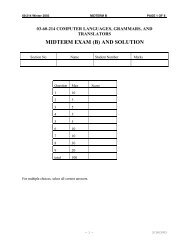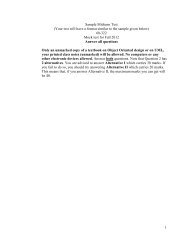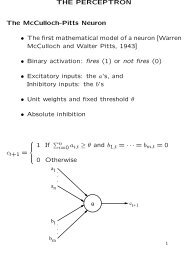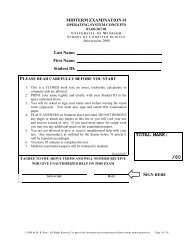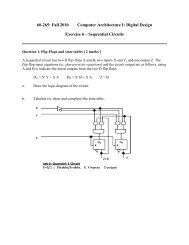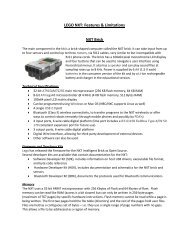Sample mid-term - University of Windsor
Sample mid-term - University of Windsor
Sample mid-term - University of Windsor
You also want an ePaper? Increase the reach of your titles
YUMPU automatically turns print PDFs into web optimized ePapers that Google loves.
59-240 Introductory Physical Chemistry I Mid-Term #2<br />
<strong>University</strong> <strong>of</strong> <strong>Windsor</strong> (R.W. Schurko) November 12, 2003, 8:30 - 9:20 a.m.<br />
Instructions:<br />
There are five questions in total. Complete the first question, and then complete three <strong>of</strong> the four<br />
remaining questions. Each question is worth 25% <strong>of</strong> the total mark (i.e., 5 marks out <strong>of</strong> a total<br />
possible 20 marks). There is a bonus question at the end worth an additional 2.0 marks that you<br />
may attempt if you have time remaining. Place all answers in the test booklets provided,<br />
surrounding final answers with a clearly marked box. Please refer to the attached<br />
information sheets for physical constants and useful equations. Good luck!<br />
1. (5 marks, you must attempt this question)<br />
(a) For the reversible adiabatic expansion <strong>of</strong> a perfect gas, state (where possible) whether<br />
∆U, ∆H, ∆S, ∆S sur , ∆S univ , ∆A and ∆G are positive, negative or equal to zero. Show all<br />
reasoning.<br />
(b) Given that T fus = 0 o C, state whether ∆S, ∆S sur and ∆S univ are equal to, greater than or<br />
less than zero (where possible) for:<br />
(i) melting <strong>of</strong> ice at T = 0 o C<br />
(ii) melting <strong>of</strong> ice at T = 10 o C<br />
and briefly explain your answers.<br />
(c) Derive the fundamental equation dG = Vdp - SdT and the associated Maxwell relation.<br />
2. (5 marks) Consider a system consisting <strong>of</strong> 1.5 mol <strong>of</strong> CO 2 (g), initially at 15 o C and 9.0<br />
atm, confined to a cylinder <strong>of</strong> gas <strong>of</strong> cross section 100.0 cm 2 . The sample is allowed to<br />
expand adiabatically against an external pressure <strong>of</strong> 1.5 atm until the piston has moved<br />
outwards through 15 cm. Assume that CO 2 can be treated as a perfect gas with C v,m =<br />
28.8 J K -1 mol -1 . Calculate (a) q, (b) w, (c) ∆U, (d) ∆T and (e) ∆S.<br />
3. (5 marks) Starting from the fundamental equation for dH, and show that<br />
where α is the expansion coefficient.<br />
MH<br />
Mp T<br />
' V(1 & αT)<br />
4. (5 marks) The standard enthalpy <strong>of</strong> combustion <strong>of</strong> solid urea, CO(NH 2 ) 2 is -632 kJ mol -1<br />
at 298 K (CO(NH 2 ) 2 (s) + (3/2)O 2 (g) 6 CO 2 (g) + 2H 2 O(R) + N 2 (g)) and its standard<br />
molar entropy is S m o = 104.60 J K -1 mol -1 . Calculate the standard Gibbs energy <strong>of</strong><br />
formation <strong>of</strong> urea at 298 K.<br />
(continued next page)<br />
Page 1 <strong>of</strong> 3
5. (5 marks) (Phase diagram problem)<br />
(a) In the low pressure phase diagram <strong>of</strong> H 2 O below, explain the significance <strong>of</strong> points A<br />
through E.<br />
(b) Explain the what the points F and G signify.<br />
(c) Why is the slope <strong>of</strong> the line along FB negative for H 2 O<br />
(d) Respond true or false to the following statements, and explain your reasoning:<br />
(i) The chemical potential at point E, µ(E), is always greater than the chemical<br />
potential at point C, µ(C).<br />
(ii) At point B, µ(A) = µ(C).<br />
(iii) For an increase in temperature at constant pressure (i.e., A to E), the entropy<br />
increases.<br />
(iv) It is possible to obtain supercritical fluid in an open vessel.<br />
6. (2 marks) Given that φ = f/p and Z = pV m /RT, prove that<br />
ln φ ' m<br />
p<br />
0<br />
Z & 1<br />
p<br />
dp<br />
End <strong>of</strong> Mid-Term #2<br />
Page 2 <strong>of</strong> 3
Useful information<br />
Units <strong>of</strong> pressure:<br />
Name Symbol Value<br />
pascal 1 Pa 1 N m -2 , 1 kg m -1 s -2<br />
bar 1 bar 10 5 Pa<br />
atmosphere 1 atm 101325 Pa<br />
torr 1 Torr 101325/760 Pa = 133.32 Pa<br />
mm <strong>of</strong> mercury 1 mm Hg 133.322 Pa<br />
pound per sq inch 1 psi 6.894 757 kPa<br />
R with different units<br />
8.31451 J K -1 mol -1<br />
8.20578 x 10 -2 L atm K -1 mol -1<br />
8.31451 x 10 -2 L bar K -1 mol -1<br />
8.31451 Pa m 3 K -1 mol -1<br />
62.364 L Torr K -1 mol -1<br />
1.98722 cal K -1 mol -1<br />
R is related to the Boltzmann constant, k, by R = k @ N A , where<br />
k = 1.3806 ×10 -23 J K -1<br />
N A = 6.022 × 10 23 mol -1<br />
amu = 1.66057 × 10 -27 kg<br />
1 m = 100 cm, 1 m 2 = 10000 cm 2 , 1 m 3 = 1000000 cm 3 , 1 m 3 = 10 3 L<br />
Unit prefixes<br />
m milli 10 -3<br />
µ micro 10 -6<br />
n nano 10 -9<br />
p pico 10 -12<br />
Data Table M ∆ f H o (kJ mol -1 ) S mo (J K -1 mol -1 )<br />
Ar 39.948 0 154.84<br />
C (s) 12.011 0 5.740<br />
H 2 (g) 2.016 0 130.684<br />
O 2 (g) 31.999 0 205.138<br />
N 2 (g) 28.013 0 191.61<br />
CO 2 (g) 44.010 -393.51 213.74<br />
H 2 O (l) 18.015 -285.83 69.91<br />
Page 3 <strong>of</strong> 3







